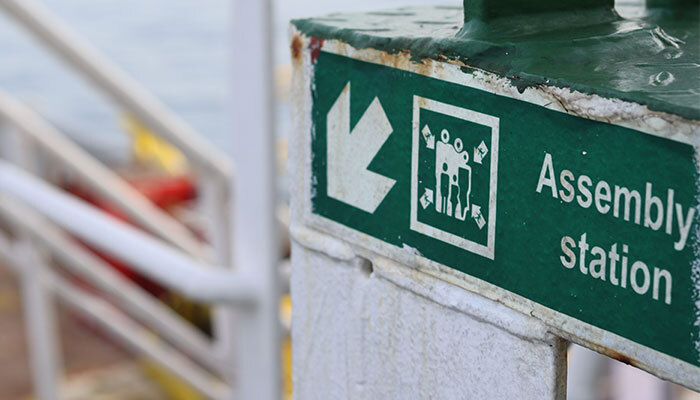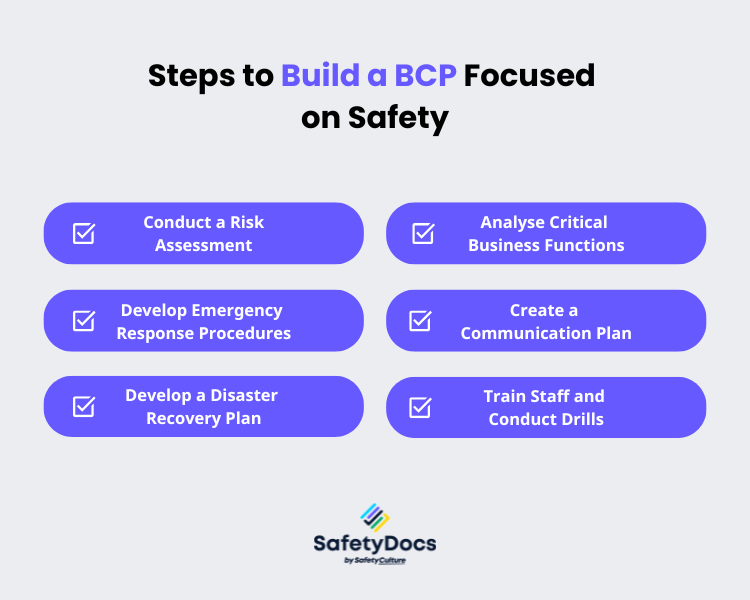When disaster strikes, how prepared is your business in keeping your workers safe and your operations running? From bushfires to cyberattacks, emergencies can take many forms - and they often come without warning. That’s why emergency preparedness and business continuity planning are no longer just good business practice, they’re essential for being proactive in protecting your people and minimising downtime.
In this guide, we outline how to build a Business Continuity Plan (BCP), with an emphasis on workplace safety. You’ll learn what the key risks to plan for, the steps to build your BCP, and how to avoid common issues. Plus, we’ll highlight time-saving tools to help you prepare with confidence.
What is a Business Continuity Plan?
A Business Continuity Plan is a structured strategy that outlines how an organisation will continue operating during and after an emergency or disruption. While it usually covers IT systems, supply chains, and essential functions, safety planning is a crucial but sometimes overlooked component.
A focused Continuity Plan ensures your workers are protected before, during, and after an incident. It supports quick decision-making, reduces harm, and helps maintain legal compliance under Work Health and Safety (WHS) laws.
Unlike a general emergency plan, this type of plan goes further by detailing how you’ll sustain operations and recover your critical services, not just evacuate or respond in the moment.

Key Risks to Consider
No two businesses face the same risks. Your continuity plan should reflect the specific threats that could impact your workplace. Some of the most common include:
- Natural disasters – bushfires, floods, storms, or earthquakes
- Health emergencies – pandemics, infectious disease outbreaks
- IT failures or cyberattacks – data breaches, ransomware, server outages
- Utilities or infrastructure issues – power outages, water contamination
- Workplace accidents – hazardous material spills, equipment failure
- Supply chain disruptions – delays in goods or materials, transnational disruptions
- Security threats – unauthorised access, workplace violence
While this list of incidents is not exhaustive, each of them can pose serious safety risks and disrupt your business’s ability to operate. A thorough risk assessment will help identify and prioritise what your business needs to prepare for most urgently.
Steps to Build a BCP Focused on Safety
Building a robust, safety-focused BCP doesn’t need to be overwhelming. Follow these core steps to get started:
1. Conduct a Risk Assessment
Every strong Business Continuity Plan starts with a thorough understanding of your risks. Risk assessments help you pinpoint potential hazards that could disrupt your operations or compromise workplace safety, whether they're internal (like equipment failure or staffing shortages) or external (such as natural disasters, cyberattacks, or supply chain issues).
Start by listing all possible emergency scenarios relevant to your business operations. Engage workers, safety representatives, and leadership in the process; those closest to the tasks often know the risks best. From there, evaluate the likelihood of each risk occurring and the potential consequences if it does.
To make this process more structured and repeatable, consider using a dedicated Risk Management Plan template. This helps you:
- Document known and emerging hazards
- Assign risk ratings using standard matrices
- Identify existing controls and any gaps
- Develop mitigation or treatment strategies
- Establish review timelines for ongoing monitoring
Pro Tip: Categorise risks by type (e.g. operational, environmental, technological, or health-related) to better tailor your response strategies. This helps not only maintain compliance with WHS obligations, but also building a plan that reflects your business's real-world challenges.
2. Analyse Critical Business Functions
Once you’ve identified the risks, the next step is to determine which parts of your operation are absolutely important to keep your business running safely and efficiently during a disruption. These are your critical business functions, and protecting them is at the heart of any effective Business Continuity Plan.
You can start by asking:
- Which services or processes are mission-critical?
- What personnel, systems, or equipment are vital to maintain or restore quickly?
- Which suppliers or external partners do we rely on heavily?
- What safety systems or compliance measures must remain operational, even in a crisis?
This analysis allows you to pinpoint dependencies, the interconnected parts of your business that could create a domino effect if compromised. Mapping these out ensures you prioritise your safety planning around the areas with the highest impact on health, compliance, and continuity.
For example, if your operation depends on cold storage to preserve temperature-sensitive products, a power outage isn’t just a logistical issue; it could become a serious safety risk. Or, if certain staff are trained to manage hazardous materials, their absence during an emergency may compromise safety protocols.
Pro Tip: Document critical functions alongside Recovery Time Objectives (RTOs) and Recovery Point Objectives (RPOs). This helps set expectations for how quickly each function should be restored and guides your emergency planning accordingly.
3. Develop Emergency Response Procedures
A core element of any BCP is having clear and actionable emergency response procedures that kick in the moment a crisis occurs. These procedures aren’t just about restoring operations, they’re about keeping people safe in the immediate aftermath of an incident.
Start by designing your response actions according to the specific risks identified in your assessment. Different threats require different safety measures, and the time needed to complete those actions should also be considered. From evacuating a facility during a fire to securing hazardous materials in a containment breach, every action plan should be designed to reduce harm and ensure legal compliance.
Here are some essential response procedures to document:
- Evacuation plans for fires or hazardous leaks
- Shelter-in-place procedures during chemical spills or airborne threats
- First-aid and medical response protocols, including access to trained responders and supplies
- Emergency contact lists for local authorities, emergency services, and utility providers
These procedures should align with your legal obligations under WHS laws. A helpful starting point is Safe Work Australia’s Emergency Plans Overview and Emergency Plans Fact Sheet, which outline what emergency plans must include and how to implement them.
Pro Tip: For a ready-made foundation, explore our Emergency Response Management Plans, developed to meet the specific needs of Australian (and New Zealand) workplaces.

4. Create a Communication Plan
When an emergency strikes, confusion and lack of clear communication can quickly increase safety risk. A well-structured communication plan ensures the right messages reach the right people at the right time, reducing panic, preventing injury, and helping critical business operations continue or resume quickly.
Your communication plan should outline who needs to be contacted, what they need to know, how the message will be delivered, and who is responsible for sending it. The goal is to keep everyone, from frontline workers to external partners, informed and coordinated during disruption.
Your plan should include protocols for:
- Alerting staff, contractors, and visitors during emergencies (e.g. evacuations or lockdowns)
- Contacting emergency services and notifying relevant authorities or regulators
- Communicating with customers or suppliers about delays, closures, or service changes
Assigning clear communication roles, such as an emergency spokesperson or internal comms lead - Providing post-incident updates to staff and stakeholders
It’s also critical to build in redundancy. Relying on just one channel (like email) is risky, especially if IT systems go offline or get disrupted. Use a mix of communication methods such as SMS alerts, loudspeakers, internal messaging apps, or printed signage. Consider accessibility as well, ensure messaging reaches all workers, including those with language barriers or hearing impairments.
A clear, well-practised communication plan supports both emergency preparedness and ongoing workplace safety during uncertain moments.
5. Develop a Disaster Recovery Plan
Once the immediate crisis is contained, how will your business recover operations? A Disaster Recovery Plan (DRP) details the structured steps your business will take to restore critical systems, operations, and infrastructure following a disruptive or unexpected event.
This plan should go beyond basic restoration. It must consider how to resume operations without compromising worker safety, meet legal obligations, and protect your organisation’s reputation and service delivery.
Key components of a Disaster Recovery Plan include:
- Recovery of IT systems and data - ensuring secure backups, alternative access routes, and cybersecurity protections
- Relocation strategies - identifying backup sites or remote working setups if your physical premises are unusable
- Supply chain recovery - working with alternate suppliers or logistics partners to maintain operational flow
- Timeframes for staged recovery - prioritising which systems or departments need to come online first
- Ongoing worker safety protocols - such as reassessing risks at temporary sites or during infrastructure repairs
6. Train Staff and Conduct Drills
Your plan is only as effective as the people who carry it out. Emergency preparedness requires ongoing training, not just a one-time briefing. Ensure all workers, including new employees, contractors, and part-time staff, are aware of the procedures, understand their responsibilities, and know how to act under pressure.
Effective safety training should be:
- Practical and scenario-based - use realistic drills (e.g. fire evacuations, chemical spill responses) to build confidence
- Inclusive and accessible - make sure procedures are clearly communicated and understood across roles and language needs
- Updated regularly - refresh training when new hazards arise, processes change, or after incident reviews
- Collaborative - involve staff in planning and debriefs to identify gaps and encourage ownership
For guidance on best practices, see Safe Work Australia’s Emergency Plans for Workers, which highlights the importance of accessibility, worker consultation, and continuous improvement.

Common Mistakes to Avoid
Even well-intentioned plans can fall short if not properly maintained. Here are some issues to watch for:
Outdated or Incomplete Plans
Emergency plans should be reviewed at least annually and immediately after an incident or organisational change. An outdated contact list or obsolete procedure can cost precious time in an actual crisis.
Poor Communication Strategies
Without clear roles or channels for effective communication, confusion and panic can set in. Ensure your plan includes designated spokespersons, escalation procedures, and multiple contact methods.
Lack of Worker Involvement
Workers are often the first to notice hazards. Involve them in planning and review processes to ensure the plan is practical, accessible, and effective.
Skipping the Recovery Phase
Too many plans stop at the response stage. Don’t forget to include disaster recovery and risk mitigation strategies that support safe, long-term recovery.
SafetyDocs Solutions
Knowing how to create a Business Continuity Plan for workplace safety takes time, but you don’t have to start from scratch. SafetyDocs by SafetyCulture offers professionally developed templates tailored to Australian and New Zealand WHS requirements:
1. Business Continuity Plan
Stay operational when it matters most. This template helps you prepare for disruptions that could impact your business, whether due to natural disasters, supply chain issues, cyber incidents, or unexpected workforce shortages. It provides a clear framework to assess critical functions, identify recovery priorities, and outline contingency procedures to maintain service delivery.
Suitable for businesses of all sizes, it ensures you're not just reacting to a crisis but are ready to keep moving through it.
2. Emergency Response Management Plans
Be prepared for a wide range of workplace emergencies. These plans cover everything from chemical spills and confined space rescues to electrical incidents, excavation collapses, and disaster recovery. Ideal for high-risk or remote work environments, they help protect workers and minimise operational disruption.
3. Disaster Recovery Plan
Quickly bounce back after a crisis. This editable plan helps ensure businesses are prepared for unexpected disasters and accidents, minimising downtime and ensuring rapid recovery. It outlines strategies to identify risks, protect critical operations, and implement effective continuity and recovery measures.
4. Risk Management Plan
Take control of your risks with a plan that supports risk identification, assessment, and treatment. This plan ensures that all stakeholders, including employees, contractors, and inspectors, have access to up-to-date and effective risk management strategies.
All templates are instantly downloadable, compliant, and designed to save you time, so you can focus on what matters most: keeping your people and your business safe during an emergency.
Need help getting started?
Browse our full range of Emergency Response, Disaster Recovery, Business Continuity and Risk Management plans. Contact us today to equip your business for the unexpected.
Our team of experts is dedicated to providing accurate and informative content. Craig Cruickshank, our senior HSEQ advisor at SafetyDocs by SafetyCulture has reviewed this blog post to ensure the highest level of quality.
Learn more about Craig's work on LinkedIn for more industry insights.
Available for instant download and supplied in fully editable MS Word format for use in your business.
Please note that the above information is provided as a comment only and should not be relied on as professional, legal or financial advice.
Share This Article
